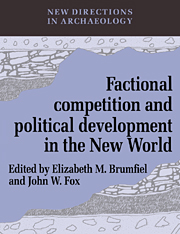Book contents
- Frontmatter
- Contents
- List of figures
- List of tables
- List of contributors
- Preface
- PART I INTRODUCTION
- PART II CHIEFDOMS
- PART III STATES
- 7 Ethnicity and political control in a complex society: the Tarascan state of prehispanic Mexico
- 8 Ethnic groups and political development in ancient Mexico
- 9 Factional divisions within the Aztec (Colhua) royal family
- 10 Alliance and intervention in Aztec imperial expansion
- 11 Political factions in the transition from Classic to Postclassic in the Mixteca Alta
- 12 Internal subdivisions of communities in the prehispanic Valley of Oaxaca
- 13 Cycles of conflict: political factionalism in the Maya Lowlands
- 14 Political cosmology among the Quiché Maya
- 15 Factions and political development in the central Andes
- PART IV DISCUSSIONS
- Bibliography
- Index
9 - Factional divisions within the Aztec (Colhua) royal family
Published online by Cambridge University Press: 18 December 2009
- Frontmatter
- Contents
- List of figures
- List of tables
- List of contributors
- Preface
- PART I INTRODUCTION
- PART II CHIEFDOMS
- PART III STATES
- 7 Ethnicity and political control in a complex society: the Tarascan state of prehispanic Mexico
- 8 Ethnic groups and political development in ancient Mexico
- 9 Factional divisions within the Aztec (Colhua) royal family
- 10 Alliance and intervention in Aztec imperial expansion
- 11 Political factions in the transition from Classic to Postclassic in the Mixteca Alta
- 12 Internal subdivisions of communities in the prehispanic Valley of Oaxaca
- 13 Cycles of conflict: political factionalism in the Maya Lowlands
- 14 Political cosmology among the Quiché Maya
- 15 Factions and political development in the central Andes
- PART IV DISCUSSIONS
- Bibliography
- Index
Summary
The Aztec or Colhua royal family in the prehispanic Mexican empire was the real heart of the political elite in Aztec society. This principal family resided in the great city of Mexico-Tenochtitlan, and was related by affinal and consanguineous ties to the leading families in the other important centres of central Mexico and beyond. The families of Mesoamerican chieftains were polygynous, and in many of these, including the Aztec royal family, political succession was decided by election. Where both characteristics operated together, many mothers with sons or daughters who were potential candidates for positions of rule lived together in palacecompounds with many officials who were often their own or their children's relatives. We don't have to tax our imaginations to expect a rather fertile ground for the flowering of political intrigues and the resulting factional divisions.
In addition to these two factors, two other characteristics of Mesoamerican systems of government contributed to factionalism: the almost omnipresent dual organization of local rule and the typically bilateral systems of kinship and inheritance. The dual organization meant that on every level of some importance there were two co-rulers, both occupying equal positions in the hierarchy of government but with different functions. Usually, one ruler was responsible for the external relations of the domain whereas the other was mainly in charge of the maintenance of internal order and justice. Conflicts between the two co-rulers were possible of course, and some violent ones are recorded in Toltec and Aztec historiography.
- Type
- Chapter
- Information
- Factional Competition and Political Development in the New World , pp. 103 - 110Publisher: Cambridge University PressPrint publication year: 1994
- 4
- Cited by



